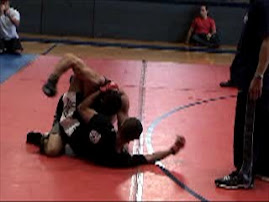 One of the news stories gaining quite a bit of attention over the past 24 hours is the fact that two girls qualified for this year's varsity state wrestling tournament in Iowa. For those unfamiliar with the sport, high school wrestling in Iowa is, well, an obsession. It is huge there.
One of the news stories gaining quite a bit of attention over the past 24 hours is the fact that two girls qualified for this year's varsity state wrestling tournament in Iowa. For those unfamiliar with the sport, high school wrestling in Iowa is, well, an obsession. It is huge there.Wrestling is one of many traditionally male sports, and in most states, high school wrestling is so dominated by boys that girls essentially never sign up, or if they do, they must practice with and compete against males. Conversely in Hawaii, high school wrestling is so popular among girls that girls wrestling has its own infrastructure; at many schools they have their own coaching staff. Likewise at the end of the year the girls and boys wrestling teams in Hawaii have their own separate tournaments - but held in the same arena at the same time - where individual wrestlers and teams for boys and girls are crowned state champs.
But even in Iowa, where wrestling reigns king, girls must enter the male-dominated wrestling system. Hence, when girls are successful enough competing against boys in the regular season and qualify for the state tournament, it is big news and comes with a bit of added drama.
One of the girls who qualified for Iowa's tournament lost her two first matches, thereby eliminating her from further competition. Another girl, however, won by default because her male opponent did not feel it was appropriate to compete against a girl. He respectfully bowed out of competition stating:
"I have a tremendous amount of respect for Cassy and Megan (Black, the tournament's other female entrant) and their accomplishments. However, wrestling is a combat sport and it can get violent at times. As a matter of conscience and my faith, I do not believe that it is appropriate for a boy to engage a girl in this manner. It is unfortunate that I have been placed in a situation not seen in most of the high school sports in Iowa."
And it should not go unmentioned that this male competitor had a record going into the tournament of 35-4, giving him a legitimate chance to place, illustrating how strongly he felt about not wrestling against a girl even though she'd qualified by competing against boys throughout the season.
This all serves as a perfect example of the social tensions that Eileen McDonagh and Laura Pappano discuss in their book, Playing With the Boys: Why Separate is Not Equal in Sports. At least in explicit principle, if we do not segregate education and work by way of sex, then why should we segregate sport? Shouldn't athletic competition be based predominantly on ability, which would enable boys/girls and men/women to compete with and against each other?
McDonagh and Pappano argue that by segregating the sexes in sport, we further the broader social inequalities between the sexes. Women are further seen and treated as second-class citizens.
There are other perspectives, however, and not just those that would callously diminish women's upward mobility in sport. Take for instance the sport of track & field. If women and men competed with/against each other in sprinting events such as the hurdles, and let's assume the male standard was kept in the 110m high hurdles, how many fantastic, elite female hurdlers who now compete in the women's 100m race with lower hurdles could effecitvely clear the hurdles and sprint through them when raised to 42 inches?
If a woman/girl could do so, she should not be excluded - a key point made by McDonagh and Pappano. But I would not go so far as to eliminate an infrastructure that caters to women's smaller, on average, physical size. If we went that far, some important female role models would lose status and the rewards they have worked hard to attain.
In the case of the girls who are competing in Iowa's state wrestling tournament, we see an example where a sporting infrastructure for girls has not been established. And that is the unfortunate aspect of this story. With wrestling being so popular in Iowa, it is unfortunate that girls are not encouraged nearly as much as boys to partake in this sport. Why, because it is too violent? Girls cannot handle physical competition?
Bottom line, the athletic system is not established in a way to promote gender equity. If Iowa has a wrestling system like Hawaii that provided more expanded coaching and competitions for girls, more girls could work their way towards state recognition in a sport that garners extensive attention in Iowa. Why deprive girls of the sport's benefits when coaches constantly say, "Sports are an extension of the classroom"? Wouldn't that be institutionalized gender discrimination in education? Fix the system.

academics online



















